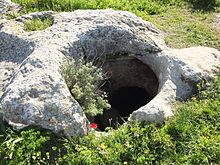Sokho
[3] The other ruin is situated on a hilltop overlooking the Elah Valley between Adullam and Azekah (Joshua 15:35), in the lower stratum of the Judaean foothills (grid position 147/121 PAL).
The site, occupied as early as the Iron Age, was visited by Claude Conder in 1881, who writes that it was already a ruin in his days, with two wells in the valley towards the west.
The biblical account states that the Philistines encamped between Sokho and Azekah in the Valley of Elah before Goliath's historic encounter with David, the son of Jesse (1 Samuel 17:1).
In late March, the entire hill is covered with wild blue mountain lupines (Lupinus pilosus) and becomes a popular outing destination for Israeli families.
On the elevated plateau, one can see the foundations of ancient dwellings carved into the bedrock with individual chambers divided by broken stone protuberances.
Potsherds dating to the Late Bronze Age and later periods were gathered, along with a terracotta figurine of reddish-brown clay depicting a naked woman.
An intensive survey conducted in 2010 included an examination of Middle Bronze and Iron Age burial caves, as well as slag from a pottery workshop (which probably dates to the Crusader/Mamluk period).

